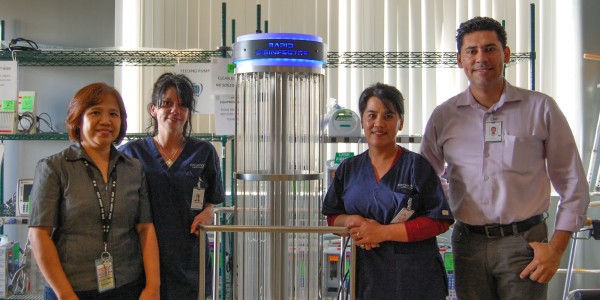“Hasta la vista, baby,” says UV ‘robot’ to germs at Lions Gate Hospital
Lions Gate Hospital has a new weapon to wipe out c. difficile bacteria and other dangerous pathogens. This terminator goes by the handle R-D™.
Selected as the machine of choice after thorough testing, and received through the generous support of a Lions Gate Hospital Foundation donor, the R-D™ – short for Rapid Disinfector™ — delivers lethal doses of ultraviolet light to destroy viruses, spores and drug-resistant bacteria.
Cleaning machine on wheels
Operated by specially trained Environmental Services (EVS) cleaning staff, the R-D™ complements — not replaces — the current room cleaning regime. During the day, R-D™ is devoted to the Paul Myers acute tower. In the late afternoon and early evenings, it’s deployed to the operating rooms.
“We’re targeting areas where it’s needed most – typically in multi-bed rooms,” explains Rosma Facundo, Infection Control Practitioner.
But it’s not a simple process of sending R-D™ into a room and the work is done. It’s a team effort that requires a lot of coordination on the part of clinical and EVS staff. First the room must be cleaned, decluttered and vacated before R-D™ can be sent in to work its magic.
“Kudos to the teams that make it happen,” says Rosma. “It really does require a coordinated effort and staff should be recognized for the work they do in this area.”
R-D™ part of broader initiative
A dynamic duo of disinfection power, cleaning staff teamed with the R-D™ are part of a broader initiative — including decluttering, antimicrobial stewardship and improved isolation procedures — aiming to reduce infection rates to zero. Research has shown that UV disinfection can kill 99.99 per cent of live pathogens, such as c. difficile, methicillin-resistant Staphylococcus aureus (MRSA), and norovirus.
“Regular and enhanced cleaning is effective to address the majority of surfaces soiled with organic matter, dirt and grime,” says Jody Sydor Jones, Coastal Director for Quality and Patient Safety. “UV disinfection is an added step to treat surfaces that may have residual matter that can contribute to the transmission of hospital-acquired infections. We want to do everything in our power to eradicate the sources of infection, to be able to provide the best, and safest, care possible.”
Deadly to the pathogens only
The R-D™ performs its work quietly. It’s perfectly safe for us to watch it at work through a window – the UV light isn’t harmful when viewed through glass. It’s also safe to breathe the air if you’re in the vicinity of R-D™ working. The machine doesn’t produce ozone and the slight odour it emits is non-toxic.
“What you smell after the R-D™ has been in the room is the smell of success. Essentially, it’s the smell of any remaining organic matter being combusted and zapped off the surfaces that the light reaches,” says Jody. The smell rapidly disappears as the room is readied for the next patient, and what’s left is a greater sense of security – that the room is not only clean, but disinfected too.
In fact, with the R-D™ on our team, we’re not actually saying “Hasta la vista”, which translates to “See you later.” What we’re really saying to these germs is “Adios,” or “Good-bye…for good!”
Staff wanting to use R-D™ should contact the nursing unit PCC, in collaboration with a recommendation from Infection Control, who will contact EVS to deploy the R-D™.
In the meantime, we can all do our part by practising good hand hygiene especially with cold and flu season nearly upon us. Our patients will thank us for it.

